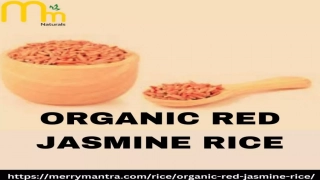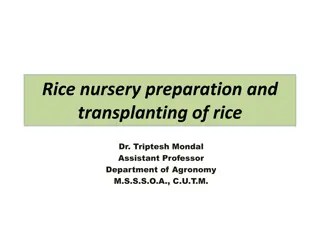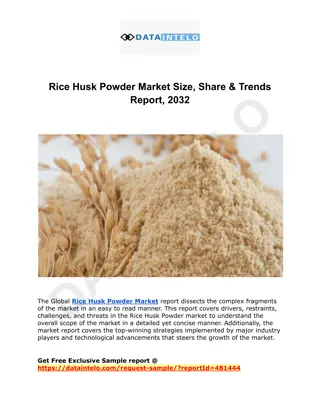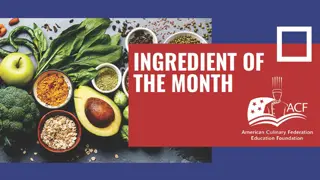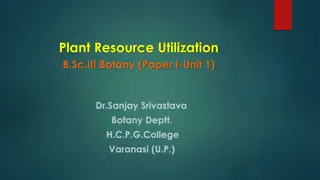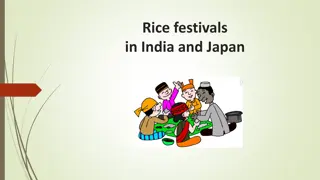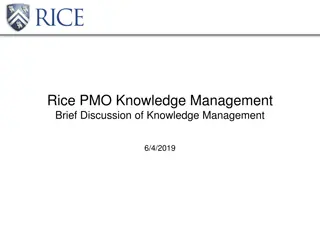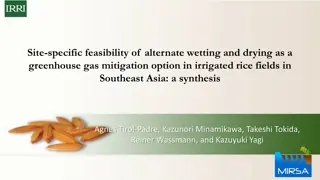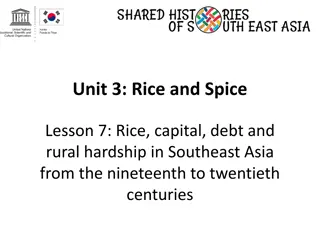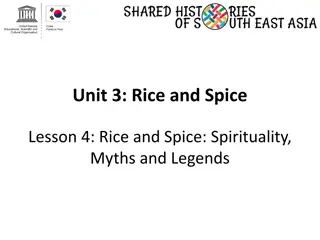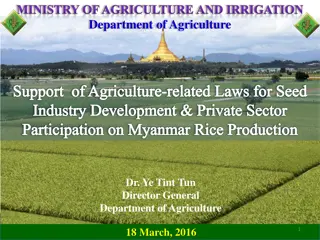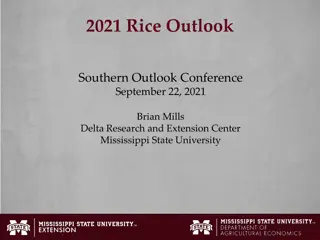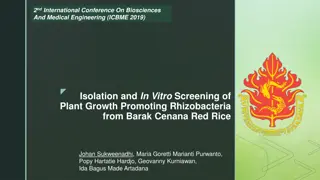
Rice: Scientific Facts and Culinary Implications
Discover scientific insights into rice, including its carbohydrate and protein content, starch composition, and culinary characteristics. Explore the influence of amylose and amylopectin on rice texture, different types of rice grains, and the nutritional value of rice bran. Learn about the impact of climatic factors on rice yield and cultivation.
Download Presentation

Please find below an Image/Link to download the presentation.
The content on the website is provided AS IS for your information and personal use only. It may not be sold, licensed, or shared on other websites without obtaining consent from the author. If you encounter any issues during the download, it is possible that the publisher has removed the file from their server.
You are allowed to download the files provided on this website for personal or commercial use, subject to the condition that they are used lawfully. All files are the property of their respective owners.
The content on the website is provided AS IS for your information and personal use only. It may not be sold, licensed, or shared on other websites without obtaining consent from the author.
E N D
Presentation Transcript
RICE Scientific name : Oryza sativa L. Family: Poaceae (previously known as Gramineae) Chromosome no.: 2n=24 (Diploid species) Dr. Triptesh Mondal Assistant Professor Department of Agronomy M.S.S.S.O.A., C.U.T.M.
Center of Origin: Indo-Burma region (Vavilov, 1926) Rice grain contains carbohydrate: 74.8%, protein: 8.4%, but in milled rice: 6-7% (namely Oryza protein has digestive efficiency: 87% and biological value: 51%) and fat: 2.6% The broken rice used as poultry feed and Fishery feeds. Rice grains contains two types of starch. These are amylose and amylopectin. The amount of these two starch determines the texture (whether it is firm or not) of cooked rice and whether it will be fluffy or sticky.
Amylose is a long, straight starch molecule that does not gelatinize during cooking. Amylopectin is a highly branched starch molecule that is responsible for making rice gelatinous and sticky. If amylopectin content is found high (about 2-3%) and amylose content is least in grains then rice becomes sticky or non-fluffy after cooking (e.g.: short grain rice generally Asian style type of rice). When amylose content is found high (about 22%) and amylopectin is found least in grains, then rice becomes non- sticky or fluffy after cooking (e.g.: long grain rice varieties such as Basmati and Jasmine).
The characteristics of some medium grain rice tend to fall somewhere in between. They contain about 15-17% amylose and a good amount of amylopectin which results in a creamy consistency (e.g.: Italian, Arborio and Paella style types of rice). Sticky rice/Glutinous rice/Waxy rice/Sweet rice: This type of rice becomes very sticky when grains are cooked. This rice contains highest amount of amylopectin and no amylose and often used to make sweet dishes in Asia. Lesser the amylopectin content in rice kernels finer the rice quality which is preferred in domestic and international market.
Rice bran is also known as millers bran. It is the hard outer layer after hull/husk (made of lemma and palea). Bran consists of the combined aleurone and pericarp. Along with germ it is an integral part of whole grain and often produced as a byproduct of rice milling. Rice bran contains 12-14% protein and 20-25% fat/oil. It is used as cattle feed. After dehulling/dehusking (by threshing), rice grains/kernels have outermost aleurone layer until milling is done. This type of rice is known as Brown rice and after milling, the rice is known as milled rice or white rice.
Some climatic factors have greater influence on rice yield. These are: Solar radiation : Solar energy is the most important climatic factor in rice cultivation in temperate climates. The plant s most critical period of solar energy requirement is from Panicle Initiation to until about 10 days before maturity which is important for the accumulation of dry matter. Temperature : It greatly influences the growth and growth pattern of rice plant. Temperature variations are low in tropics and hence needs no significant consideration for the rice cultures in these areas. Day Length : Rice is a short day plant and sensitive to photoperiod. But now a days, HYVs and hybrids have been developed which are not photo sensitive but thermo sensitive.
Relative Humidity : The average RH before harvest follows a trend opposite to that of the solar radiation values for the same period. Wind Velocity : Strong winds are most detrimental especially at 15-20 days after flowering. They cause severe lodging and shattering of grains (before harvesting) in some rice varieties. Rainfall : Variability in the amount and distribution of rainfall is most important factor limiting the yields of rainfed rice, which constitutes about 80% of rice grown in South & SE Asia. Rice is grown in rainfed conditions with rainfall of 1000-1500 mm/annum, if evenly distributed over 3-3 months. The water requirement of rice is 1200-1250 mm in kharif season.
S. No. S. No. Growth Stage Growth Stage Cardinal Temperature ( Cardinal Temperature ( C) C) Low 15-16 High 45 Optimum 18-40 1. Germination 2. Seedling emergence and establishment 12-15 35 25-30 3. Rooting 16 35 25-28 4. Leaf elongation 7-12 45 31 5. Tillering 9-16 33 25-31 6. Panicle initiation 15 - - 7. Booting and Heading 15-20 30 18-28 8. Flowering/Anthesis 22 35-36 26.5-29.5 9. Ripening 12-18 30 20-25 The base temperature (i.e., minimum temperature below which growth ceases) of rice is 10 C.
Genus Oryza includes 24 species, of which 22 are wild species and 2 namely O. sativa and O. glaberrima are cultivated species. All the varieties found in Asia, America and Europe belongs to the species O. sativa and varieties found in West Africa belong to the species O. glaberrima . Based on geographic adaptation and morphological characters of the cultivated sativa rice varieties of the world can be broadly divided into 3 sub species viz., Indica, Japonica and Javanica.
Indica : The traditional varieties raised in tropics and sub-tropics (like: India) are called Indica varieties. These are traditional long duration varieties, photosensitive (season bound), mostly awnless or posses short and smooth awns. They are tall, weak stemmed and susceptible to lodging and less responsive to heavy fertilizer doses. Leaves of the plants have slightly pubescent and pale green in colour. Japonica: These are sub-tropical and warm temperate region varieties developed in Japan have dwarf in stature with sturdy stems & thus non lodging. Leaves are short, thick, narrow and dark green in colour. They are awnless or awned varieties. Grains are mostly round or oval in shape and varieties are fertilizer responsive. Javanica: These are intermediatory to Indica and Japonica, having morphological resemblance to indica varieties. Stiff straw, long panicle with awned grains, low/sparse tillering and low sensitive to photoperiod. These are found in equatorial belt of Indonesia.
Life cycle of rice plant can be classified into 3 phases: The Vegetative Phase The Reproductive Phase The Ripening/Maturity Phase 1. The vegetative phase 1. The vegetative phase It begins with germination and ends with panicle initiation. Unlike the reproductive and maturity phases which are of almost equal duration for all rice varieties (i.e., reproductive phase + maturity phase take 60 days), the vegetative phase varies considerably in length as per the climatic condition and duration of the variety. The vegetative phase can be divided into three stages: 1. Seedling stage/Nursery stage (Germination to transplanting) (initial 20-25 days): Fromseed germinating to the time when young plants becomes independent of food reserve of the seed.
2. Active vegetative stage/phase (Transplanting to Jointing stage): This stage includes the following sub stages: Recovery stage: The transplanted seedlings need/require about 7-9 days to recover from the shock of uprooting during transplanting. Rooting stage (8-10 DAT): After recovery of the plants from transplanting shock, new roots appear. It is known as rooting stage. Once the plants have good established roots, tillers develop rapidly and increase to a maximum number. Maximum tillering stage (35-42 DAT/60 DAS): Tiller height and straw weight increases during this stage. The tiller number increases until maximum tiller number is reached, after which some tillers die and the number of tillers decline and then becomes stable. Tillers are 3 types (total 40 tillers/plant). These are primary tillers (4-5 in number), secondary tillers (15-25 in number) and tertiary tillers (9-10 in number). Jointing stage/Internode elongation and stem development (60-70 or 90 DAS depending on the duration of variety): During the jointing stage, among all rice varieties, the internodes undergo a rapid growth sport and quickly lengthen (like a radio aerial extending), causing the culm/stem to grow up from the base of the plant. a) b) c) d)
3. Vegetative lag stage/phase (Stem elongation stage to panicle initiation stage): This is the transition phase between reproductive and vegetative phase. It includes two sub stages viz. i. Effective tillering stage: During this stage weak tillers begin to die and strong tillers bears panicle primordia. The number of these ear bearing (i.e., potentially productive) tillers come to be fixed which is known as Effectivetillering (Primary and secondary tillers are effective tillers). ii. Non effective tillering stage: During this stage tillers which develop subsequently, do not bear panicles and ultimately die is known as non effective tillering (Tertiary tillers are non effective tillers).
2. The reproductive phase 2. The reproductive phase The duration of this phase is from panicle initiation stage to flowering stage: 35 days The reproductive phase includes the period during which the panicle forms in the uppermost internode, flag leaf sheath swells. Then panicle emerges on the uppermost node (also known as panicle base) and protrusion of 1st dehiscent anther of flowers. The reproductive phase begins at panicle initiation (PI), when the panicle (a group of spikelets) begins to develop in the uppermost internode of the culm inside the protective covering of leaf sheaths. The primary panicle is branch is divided into secondary and sometimes tertiary branches. These branches bear spikelets. The reproductive phase divided into the following stages: Panicle initiation (PI) stage Booting stage Heading stage Flowering stage i. ii. iii. iv.
From PI stage to Booting, time requirement is 15-20 days After initiation of panicle primordium, the sheath of the flag leaf (i.e., the uppermost leaf of rice plants develops at the end of jointing stage/internode elongation stage and before the development of panicle primordia) bulges/swells due to the developing panicle within it. This is the bootingstage . By the time the panicle becomes visible to the naked eye (as a tiny, transparent growth less than 2 mm in length buried within the leaf sheaths near the base of the plant), the booting stage is already underway. The booting stage, which lasts approximately 10 days among all the rice varieties. During the period of rapid growth of the panicle, demand for nutrients is high and making the early booting stage is a crucial time for fertilization. However, it is sometimes difficult to detect panicle initiation and the earliest onset of booting.
Heading stage: Heading refers to the extension of the panicle through the flag leaf sheath on the primary and secondary tillers. The heading stage lasts until 90% of the panicles have emerged from their sheaths. Generally, it takes about 7-10 days in most of the varieties. The uppermost internode continues to elongate, revealing more of the panicle above the leaf sheath of flag leaf at this stage. Flowering stage: The flowering stage begins with the emergence of the first anthers from the uppermost spikelets on each panicle. Each individual spikelet flowers for only several hours during the middle of the day on two or three successive days. Flowering begins from the uppermost spikelets and continues for approximately 7-12 days regardless of variety as the remaining spikelets successively open (the lowermost spikelets flowering at the end).
Rice is a self pollinated crop. During flowering, pollen from the anthers is transported by wind or insects to the stigma, which carry it down into the ovary where fertilization of the ovules occurs (cross pollination). Never apply fertilizer or pesticide during the period of active flowering, as the pollination process is extremely sensitive and can easily be disrupted by the presence of agro-chemicals.
3. The ripening phase 3. The ripening phase The ripening phase begins at fertilization and continues through the grain filling and ripening, approximately 30 days required regardless of variety. Grain filling occurs as nutrients and water are transported from one part of the plant to another; the process is affected by the availability of water and nutrients, and by temperature. Grain filling and ripening can be broken down into four stages: a) The Milk Stage (7-12 DAF): The endosperm first begins to form as a milky liquid. White milk is squeeze out when the spikelets are pressing by forefinger. Rice at the milk stage is very susceptible to attack by the sucking insect pests. b) The Dough Stage (2-3 wks/ 15-21 DAF) The milky liquid begins to solidify into a sticky white paste. During this time birds generally begin to be a serious problem. Soft dough: White milk is not squeeze out when the spikelets are pressing by forefinger. But a spot is formed on the spikelets. Hard dough: No spot is formed on the spikelets if these are pressing. Spikelets become yellowish.
The maturity stage (7-10 days after hard dough stage): The grain is mature, or ripe, when the endosperm becomes hard and opaque. While the grains ripen, the leaves of the plant begin to turn yellow as nitrogen is transferred from the leaves to the seed. The full maturity stage is reached when more than 90% of the grains in the panicles have ripened. Mature grains usually undergo a change in color and turn a golden brown, but under wet climatic conditions ripe grains may remain somewhat greenish. The Over-ripe Stage: If the grains are not harvested on time, the vegetative parts of the plant - stems, leaves, and roots - begin to die off. Then the over-ripe grains fall off the panicles onto the ground in a process known as shattering. Some rice varieties are particularly susceptible to shattering, and serious crop losses may occur if harvesting is not completed on time.



